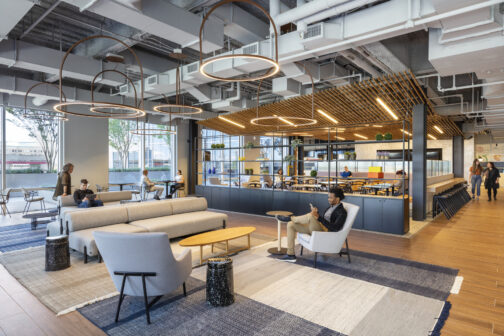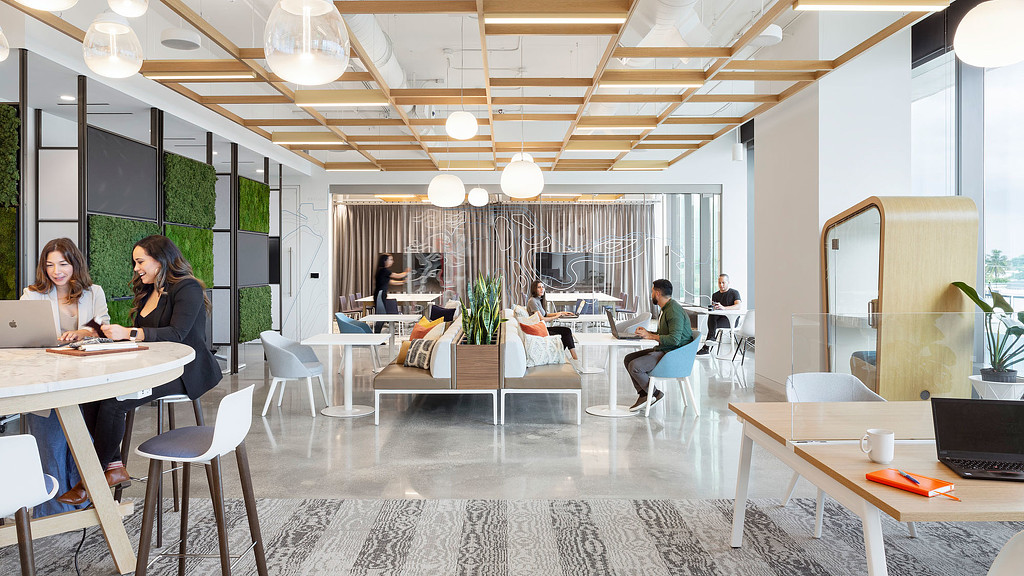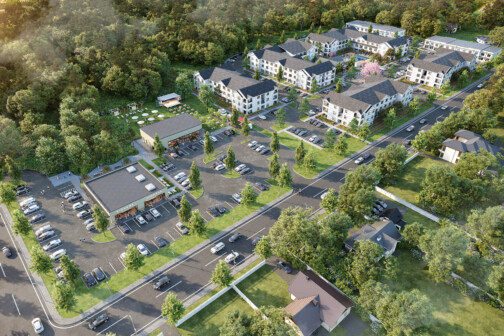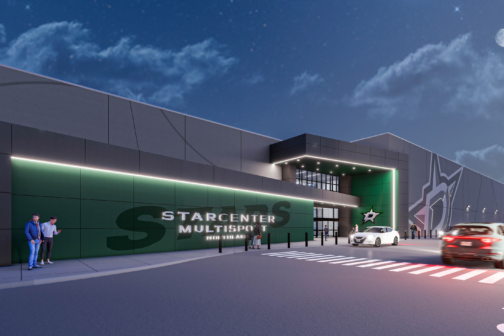During a recent discussion about the return to the office, Gensler Design Director Ian Zapata made a provocative comment about some of the underlying issues of what some are calling “the Great Resignation.”
“It’s not that younger employees don’t want to return to work,” he said. “It’s that they don’t want to return to the office.”
Working from home during a global pandemic taught workers that they could do so while still hitting productivity goals. They also learned that a flexible schedule created a much-needed balance between work and life.
Zapata said a solution might be the “third place,” another setting where people can work. The home would be the first place; the office would be second. Third place isn’t necessarily a new concept. We have long seen people working from their laptops at places such as coffee shops. What is new about the idea is that leading companies are blending the concept of first place with second to create a third place at work.
The concept is already taking hold with companies like Google, which opened a coffee shop on its campus in Mountainview, California. Named the Coffee Lab, the shop features warm wood paneling, upholstered seating, and even live music—all in the hopes of creating a comfortable, home-like environment.
Locally, AT&T’s Discovery District provides a leading example of third place. Sociologist Ray Oldenburg (the mind behind the term) called these new vignettes the “front porch” of an office or campus.
“If anybody was under the illusion that things are going to go back to the way they were, hopefully by now they realize that is not the case,” Zapata told D CEO. “This is a pivotal point, and work has changed forever.”
In this interview, he elaborates on third place, why it matters, and how the concept companies and space planners address it.

D CEO: How do current views on the office differ by generation?
ZAPATA: “Every generation sees a different place when they think of the office. It’s no surprise that younger generations, who already felt more comfortable working with digital platforms, are a lot more comfortable with the idea of a hybrid work, which is different from remote work. What is happening is that the older generations, like the Boomers and maybe Gen X, see work as a binary thing: You’re either at the office or you’re at home. They see the office as a great place to mentor and collaborate. And maybe they see the office as a great place to focus and reflect.
“Younger generations have a flip sort of approach to the office, perhaps because the places where they live might not be the best setups; or maybe they’re starting a family, and they don’t have a lot of private space. They don’t have a great home office.
“So, a lot of the younger generations see the office as a place where they can do the focus work. But they are perfectly comfortable doing all the other work at home. For them, though, home means anywhere. It could be a park; it could be a library; it could be a co-working space; it could be just a third place. They’re very comfortable using digital technology, and they don’t feel like it’s either a home or work thing.
“You may have heard the term, “the digital nomad.” It’s a generation that feels like they can work from anywhere, as long as they have an internet connection. They don’t even have to be in the same city.”
D CEO: How are your clients responding?
ZAPATA: “Companies are trying to figure out what their workplaces look like in the future—what the next 12 months to five years look like. There isn’t a single approach. Right now, there’s a lot of variety in how you try to solve this problem. But one consistent thing is this idea that hybrid workloads are here to stay.
“And this is where the generational divide comes in because the older managers, the people running the companies, aren’t necessarily very comfortable with the idea that younger people might be ready or might be very comfortable with working remotely for the majority of the time.
“I don’t want to overgeneralize. There are certain industries, such as creative industries, where you’re dealing with this dynamic between the older generation that has a lot of experience and the younger generation that are just getting started in their careers. That face-to-face interaction is important for us because we’re visual. We’re doing sketches and looking over people’s shoulders to see what’s on their screens. And that’s hard to duplicate virtually.
“In other industries, such as life sciences, which is a really hot market, those people can’t easily work remotely as the majority of their work involves specialized equipment at the office. But, for a whole host of other industries, that in-person physical demand isn’t a requirement for their everyday productivity. This is where we’re seeing that those industries are a lot more willing to explore the possibility of a smaller office footprint or less time being spent together at the office.”
D CEO: How does this all translate to the design of the office as we advance?
ZAPATA: “There are two parts to this. One is what happens in the interior of the office. Tools are still being developed to work in a hybrid environment effectively. We were talking about it just this morning in our own office. We’re realizing that we’re going to need a lot more phone rooms because of the number of virtual meetings that people are attending; when the office is full, it’s going to be disruptive.
“And so, these phone rooms that may or may not have gotten used before are now going to be in high demand. It’s almost like you can think of a phone room or a focus room as a private office shared by a large group of people. That’s a different need and requirement that we had before the pandemic.
“Additionally, in our industry, we use pinup walls, which was how we would discuss projects, we’ve gone digital with that. We use Miro Board now, and the question is, how do you collaborate? It’s a very exciting time to be in the business of designing interiors of offices because we are figuring out solutions to problems that didn’t exist 12 months ago.
“In terms of the amenities and those third places, the trend that existed before of having offices is mixed-use environments is more relevant than ever before. Because it’s not just that you’re going to the office, and then you’re going home. It’s this idea that you expect more from the office. You want to socialize, you want to have an opportunity to sit outside and have a crafted coffee or, depending on the time of the day, a glass of wine, and you’re socializing/working.
“This is a hybrid condition where the boundaries between personal and professional, social and work, are really blurred. Offices that can support that will be in high demand. And it’s not just about providing amenities just within the bounds of a particular business. It’s the ability to be in a workplace, and you can go downstairs and be surrounded by other people. It’s almost like a co-working environment that takes place in the entire city.
“This coming year is going to be a bit of a laboratory as people start coming back in full force, and we start seeing what the actual needs are. The best answer I can give you right now is that the most successful office spaces are flexible; they’re easy to modify and will accommodate solutions as we find that we need them. It’s quite difficult to predict.
“For example, we probably need a lot of focus space in the office to accommodate when we’re having hybrid meetings, and we don’t want to disrupt people in the open office. The idea of rooms with upgraded audiovisuals is a necessity going forward. Just by tracking what people are using, we’re will find out what types and sizes of conference rooms are the most useful. Is it a big conference room where everybody can fit in? Or is it a series of small conference rooms where teams can meet with the other part of the team that’s hybrid?
“It’s this big laboratory. I have seen some great solutions that people are experimenting with. But I would say right now the key is flexibility and willingness to experiment and to tinker.”
D CEO: Where are we seeing the idea of third space being done well?
ZAPATA: Right now, it’s no secret that Texas and Dallas are a magnet for relocations from other parts of the country. Companies that are coming to look for office space are looking for those types of spaces that have character, located in places where you can or walkable, where you have options for dining and entertaining. That’s the reason why Deep Ellum is very attractive, and it’s the reason why the AT&T Discovery District has been successful. The area around Klyde Warren Park, Uptown, where it’s not just an office but its office and lifestyle. All these places are hot for a reason. Even the suburban developments where there’s a mixed-use core are where all these corporate relocations want to go. And it’s just proof of the fact that the proposition of a single office is more than just the office, its office plus.”
D CEO: What are the opportunities for downtown Dallas?
ZAPATA: We see promise in the central business district–if we get it right. People still love being in cities. Even younger people want to be in exciting places. And that’s the key. They want to be in an area with walkability, where you can have that city life where you live in an apartment and can go downstairs and meet your friends at the cafe, then walk a couple of blocks and go shopping or go to the office. It’s the right kind of investment.
“Downtown Dallas has some nice parks. Some are more successful than others, and there’s a reason why. It comes down to the programming of the space and how curated the activities are. You can’t just create a beautiful park and expect that it’ll thrive.
“Klyde Warren Park is not something that happened by accident. That space is highly programmed, activities are coordinated, and there’s always something going on. It isn’t always happening organically. Same thing with AT&T Discovery District. The entertainment that’s there is not by accident. It’s curated content. It’s curated activities. There’s always something going on there, and that’s by design. For other parts of downtown. it’s buying into this idea of a curated experience and program space.”
D CEO: Can a third space be anywhere?
ZAPATA: “It could be anywhere. Here’s where we talk about placemaking. Just because it’s a place doesn’t mean that it’s a place people want to be in. There are all these rules of what makes for successful people places. A third place could be where I’m looking outside the window where there are some chairs to sit down. And it’s not just that the chairs are there; they’re comfortable, they’re easy to move so that people can control their space and have some autonomy over this space.
“There’s shade, so there’s a little bit of protection from the weather, and there’s some pleasant landscaping outside. All these components work into it. And then it’s also in a location where people will be walking by so there’s activity. It’s a space that seems alive. All these things come together to create places that people want to be in.”
D CEO: Why do you think this is especially appealing to younger generations?
ZAPATA: “Younger generations are used to this type of reading and communicating comfortably and typing from any type of device; a laptop is a very comfortable work environment. It’s not cumbersome. It’s no accident that younger generations see the third place as a viable place to work. That’s the generation exploring this whole idea of being a digital nomad—that I can work from anywhere in the world and still be connected. For older generations, people who are used to having a little bit of desk real estate, it’s a much more difficult proposition.”
Get the D CEO Real Estate Newsletter
Author






